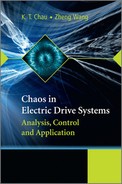Organization of this Book
This book is a happy marriage of two fields of research – chaology and electrical engineering. Chaology has always been tagged as an abstract field that involves intensive mathematics but lacks practical application. On the other hand, electrical engineering has been well recognized as a practical field that usually transforms innovative technology into commercial products, thus improving our living standards. Chaos in electric drive systems is a representative of this marriage, enabling chaos to exhibit realistic behavior and provide a practical application. It also fuels electrical engineering with a new breed of technology.
The book covers the multidisciplinary aspects of chaos and electric drive systems, and is written for a wide range of readers, including students, researchers, and engineers. It is organized into four parts:
- Part I presents an introduction to the book. It contains Chapters 1 and 2, which will provide an overview of chaos with an emphasis on electric drive systems. These chapters will also introduce the basic theory of chaos and a fundamental knowledge of electric drive systems.
- Part II is a core section of the book – namely, how to analyze chaos in various electric drive systems. It consists of Chapters 3, 4, and 5, which will discuss the analysis of chaos in DC drive systems, AC drive systems, and switched reluctance drive systems.
- Part III is another core section which explains how chaos in various electric drive systems can be controlled. It comprises two chapters, Chapters and 7, which will discuss various methods of controlling chaos, including the stabilization and stimulation of chaos. It should be noted that this book adopts the general perception of the meaning of control, rather than use the jargon of chaos theory where ‘control’ and ‘anticontrol’ represent ‘stabilize’ and ‘destabilize’, respectively.
- Part IV – which is probably the most influential part of the book – unveils and proposes some promising applications of chaos for electric drive systems. It contains three chapters (Chapters 8, 9, 10) that will be devoted to describing various applications of chaos, including the application of chaos stabilization, the application of chaotic modulation, and the application of chaotic motion.
Since these four parts have their individual themes, readers have the flexibility to select and read those parts that they find most interesting. The suggestions for reading are as follows:
- Undergraduate students taking a course dedicated to electric drive systems may be particularly interested in Parts I, II, and IV.
- Postgraduate students taking a course dedicated to advanced electric drive systems may find all parts interesting.
- Researchers in the areas of chaos and/or electric drive systems may also be interested in all parts. In particular, they may have special interest in Parts III and IV, which involve newly explored research topics.
- Practicing engineers for product design and development may be more interested in Parts I and IV, in which new ideas can be triggered by the overview, and commercial products can be derived from the proposed applications.
- General readers may be interested in all parts. They are advised to read the book from beginning to end, page by page, and will find the book to be most enjoyable.
The book contains 10 chapters, each of which has various sections and subsections. In order to facilitate a reading selection, an outline of each chapter is given below:
- Chapter 1 gives an overview of chaos, including the definition of chaos, the development of chaology, and the research of chaos in the field of electrical engineering, with an emphasis on electric drive systems.
- Chapter 2 introduces the necessary background knowledge for this book – namely, a description of the basic theory of chaos and the fundamentals of electric drive systems.
- Chapter 3 is devoted to analyzing chaos in DC drive systems, including both of the voltage-controlled mode and the current-controlled mode. The corresponding modeling, analysis, simulation, and experimentation will be discussed.
- Chapter 4 is devoted to analyzing chaos in AC drive systems, including the induction drive system, the permanent magnet synchronous drive system, and the synchronous reluctance drive system. The corresponding modeling, analysis, simulation, and experimentation will be discussed.
- Chapter 5 is devoted to analyzing chaos in switched reluctance drive systems, including the voltage-controlled mode and the current-controlled mode. Relevant discussion with verification will be given.
- Chapter describes various control approaches to stabilize the chaos that occurs in both DC and AC drive systems. A relevant discussion with verification will be given.
- Chapter 7 describes various control approaches to stimulate chaos operating at various electric drive systems. Both of the control-oriented chaoization and the design-oriented chaoization will be discussed.
- Chapter 8 presents the stabilization of chaos in various applications, including automotive wiper systems, centrifugal governor systems, and rate gyro systems. The corresponding modeling, analysis, and stabilization will be elaborated.
- Chapter 9 presents how to apply chaotic modulation to PWM inverter drive systems, hence reducing the corresponding audible noise and mechanical vibration. Open-loop and closed-loop control will both be discussed.
- Chapter 10 presents a new breed of chaos application, namely the electrically-chaoized motion – simply known as chaotic motion. Various promising applications of chaotic motion, including compaction, mixing, washing, HVAC, and grinding, will be unveiled and elaborated.
